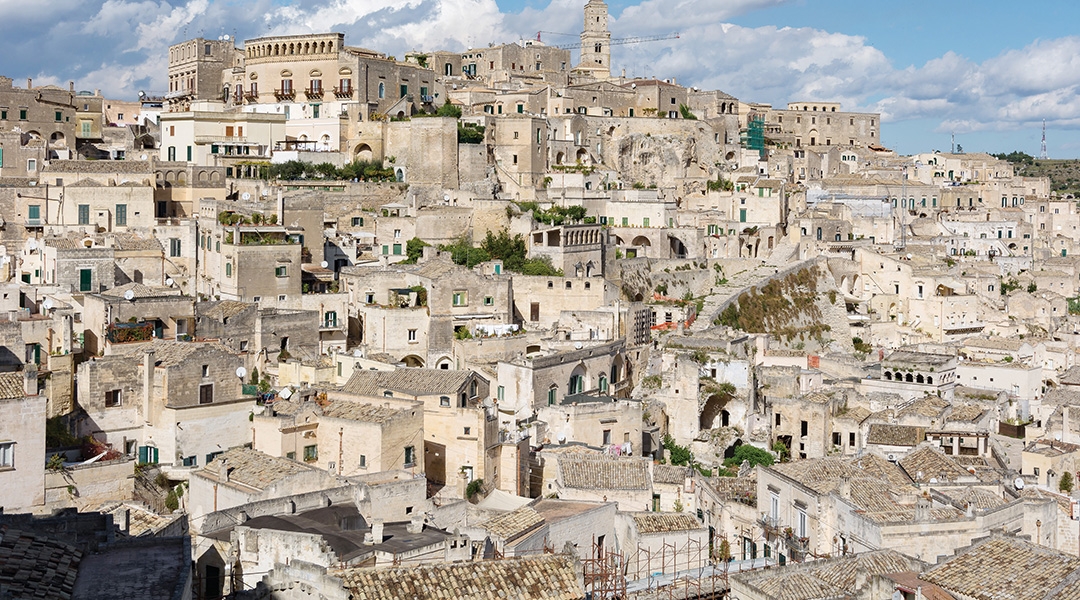My first attempt to explore Matera, one of Italy’s most ancient towns, was an exercise in picturesque frustration. I drove around rocky cliffs and limestone grottos and never found the city center, which made sense once you realize that a town built of vertical caves doesn’t really have a center.
I finally gave up and just contemplated the strangeness of Matera. Crumbling, sun-bleached buildings shimmer like a pale-gold mirage amid the hills of Basilicata, Italy’s landlocked southern hinterland. That this jumbled cityscape resembles Jerusalem is perhaps no coincidence; Jews arrived in Basilicata shortly after the fall of Jerusalem, around the year 70, and the city has long been a stand-in for the Holy Land in biblical films (Pier Paolo Pasolini’s 1964 “The Gospel According to St. Matthew” and Mel Gibson’s “The Passion of the Christ” among them).
Matera is not only home to one of the world’s oldest Jewish communities, but is one of the earliest settlements anywhere, dating back 10,000 years before the Common Era. Basilicata’s ancient Jewry persisted through Roman and Byzantine rule, gradually dispersing toward the end of the Middle Ages, never to return. By the 20th century, Basilicata in general and Matera in particular were considered an embarrassing backwater — not least for the troglodytes who populated Matera’s spooky warren of cave dwellings, known as sassi.
It was a Jewish anti-fascist activist, the Turin-born physician Carlo Levi, who propelled the sassi and their largely forgotten inhabitants to national and international attention with his 1945 memoir, “Christ Stopped at Eboli.” Penned while Levi was in political exile, the book detailed the hardships and decay of Basilicata village life and prompted Italian officials to resettle Matera’s cave-dwellers in nearby modern housing.
But in a twist Levi could never have imagined, Matera’s ancient history and unique cave-dwelling culture have become an object of worldwide fascination. In the 1990s, UNESCO recognized the sassi — along with medieval cave paintings and the frescoes that line the interiors of early Christian chapels — as World Heritage Sites.
In the global spotlight, Matera is no longer hard to find. The European Union has drawn attention to Matera’s singularity by proclaiming it a 2019 European Capital of Culture. Ancient civilizations must be this year’s theme, since the other 2019 Capital of Culture is Plovdiv, a Bulgarian Silk Road hub settled by Neolithic tribes.
Francis Ford Coppola owns a luxury resort, the Palazzo Margherita, just outside the city center. Tour buses snake up the craggy hillside; plazas are lively with café chatter, as visitors from around the world discover the richness of so-called cucina povera (“poor cuisine,” heavy on legumes and semolina wheat).
And by night, Matera’s twinkling hillsides are as enchanting as any Italian town. But in the blazing light of day, the sassi districts are an urban agglomeration like no other.
Blackened with moss and age-old grime, limestone cliffs are terraced with tiny doors, shadowy caves, and archways better suited to hobbits than modern-day people (apart from the main streets, Matera is fiercely inaccessible to all but the sure of foot). Square, hole-like windows pockmark the cliffside like jack-o-lantern teeth.
It is not hard to imagine how Roman officials, not to mention an intellectual physician from Turin, might view such dwellings as a national shame. But like another quirky, Southern Italian housing idiom — the better-known trulli dwellings of Apulia, shaped like beehives and scattered across olive groves — the sassi are now a tourist destination in their own right.
Marvel at the verticality of this architecture, which has improbably endured centuries of earthquakes as well as neglect, and where one person’s ceiling is his neighbor’s doorstep. Survival in such a landscape requires ingenuity; fresh water flowing in the ravine below Matera has been channeled uphill by cisterns since Roman times.
Like any civilization, Matera had its moments of glory, even affluence. Consider the Castello Tramontano, a 16th-century fortification, whose builder, the eponymous Count, was assassinated in a riot before finishing his castle. Of twelve planned turrets, only three were built in a squat, austere fashion reminiscent of modern-day water towers.
And on the city’s central square — the one I tried and failed to locate on my 2011 trip — is Palazzo dell’ Annunziata, a lavish edifice that reminds us we’re in Italy and not the Middle East.
Many people consider Matera to be quintessentially Italian. To me, this outpost feels more like a place apart. Suspended amid the vast, empty mountains of Basilicata, Matera is less a Capital of Culture than a literal palimpsest of European civilizations in their rawest form.
The New York Jewish Week brings you the stories behind the headlines, keeping you connected to Jewish life in New York. Help sustain the reporting you trust by donating today.





